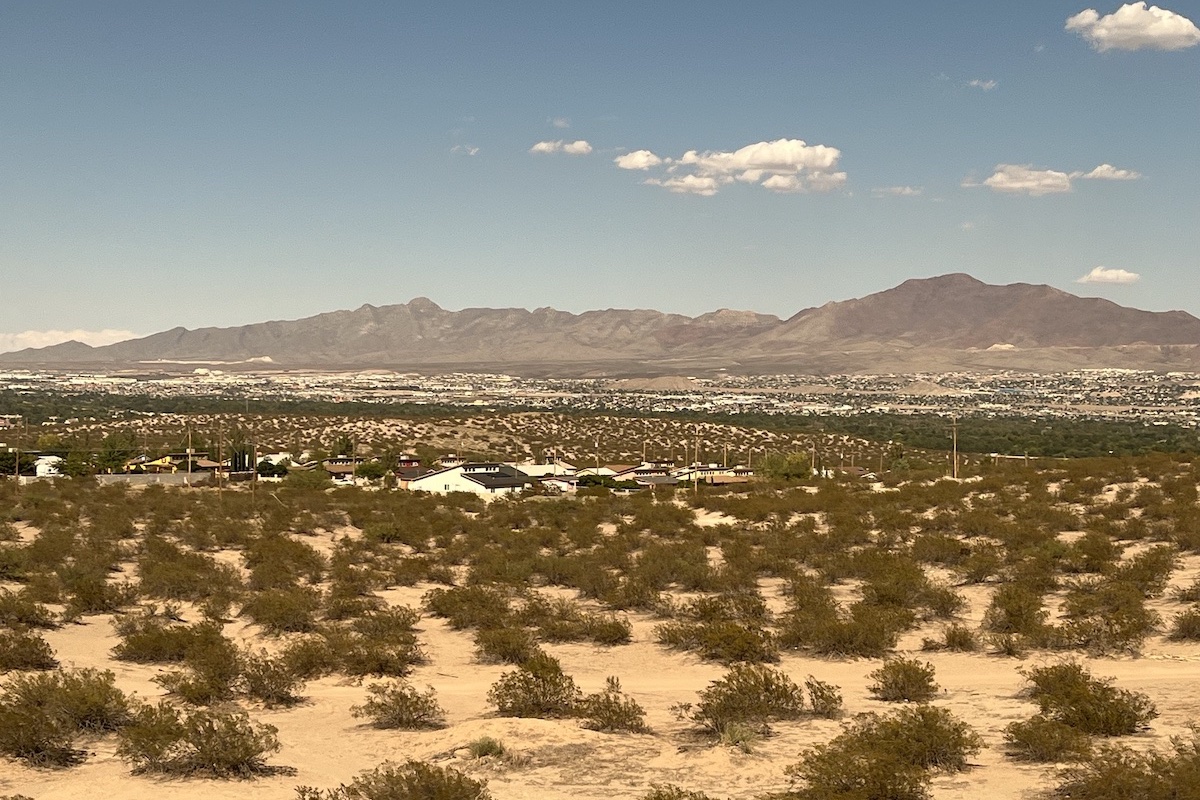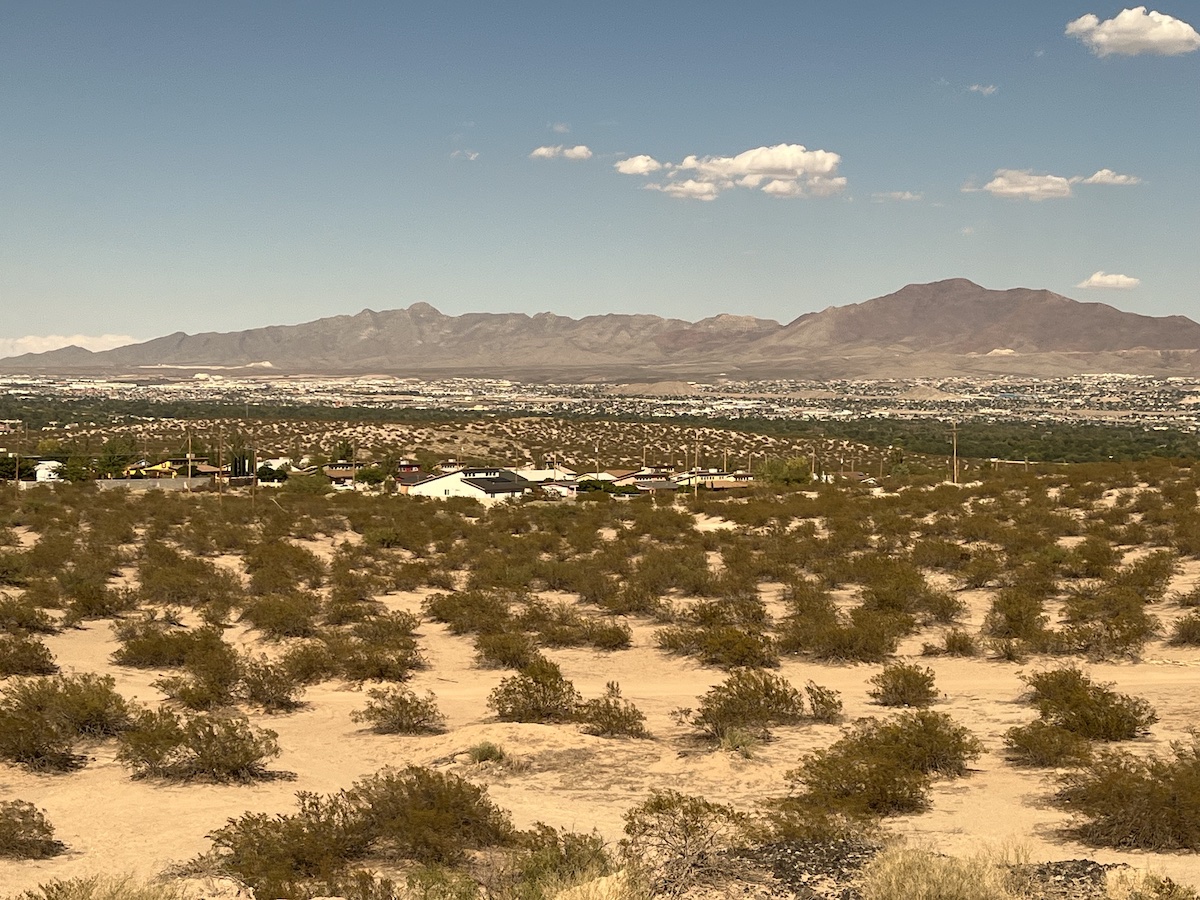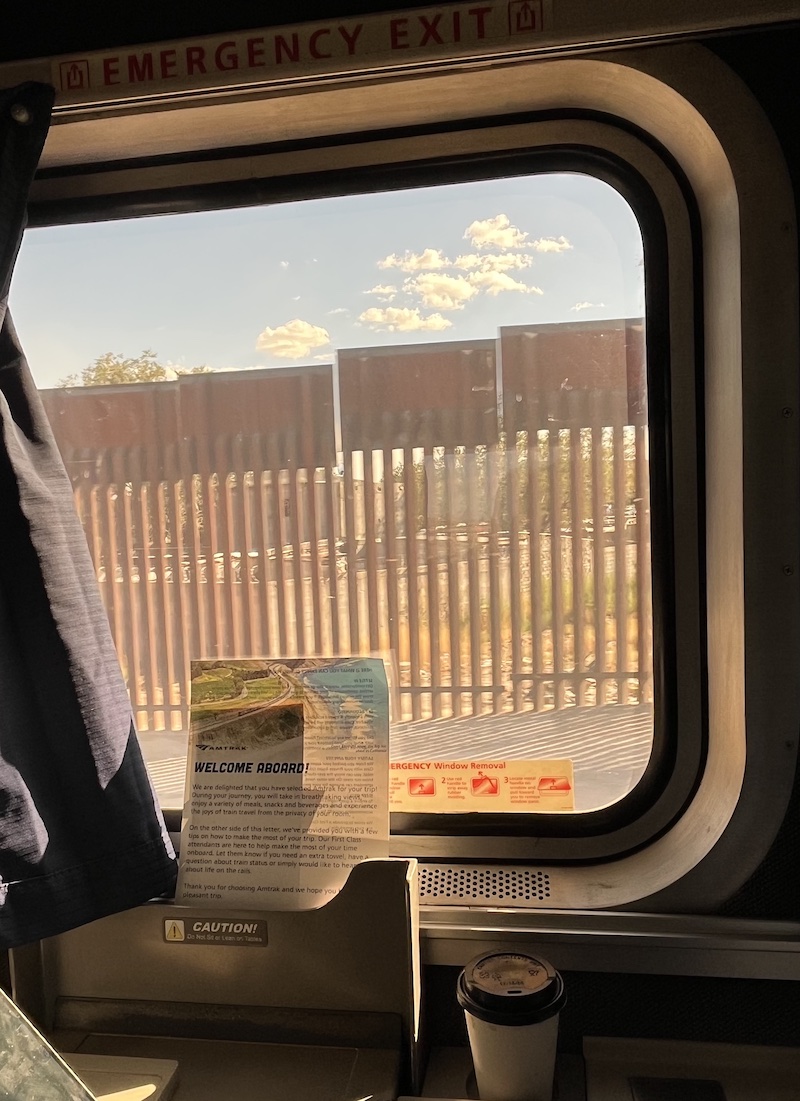
The Desert Fox: Riding Amtrak’s Sunset Limited
Skip to Section
For most folks, 46 hours crossing desert and swampland probably doesn’t sound too appealing. But that is the route of the Sunset Limited; and like most other Amtrak trips, it has much to offer the attentive traveler.
The Sunset is Amtrak Trains 1 and 2, a two-night journey running west (No. 1) or east (No. 2) between New Orleans and Los Angeles. A friend and I rode it eastbound in October 2023, finding the journey restful, lovely and enlightening.

On the platform at LA’s Union Station as Amtrak’s Sunset Limited prepares for its 10 p.m. departure.
Lounging Around
In unintended keeping with its name, the Sunset Limited is one of just two Amtrak overnight trains that operates only three days a week, rather than daily; likewise, it’s one of only two such routes that neither of us had ever ridden.
As Amtrak veterans, John and I opted for the spacious “family bedroom”—a mid-level sleeper accommodation between the tiny roomettes and the larger deluxe. The advantage of these “family” rooms is that they span the entire width of each bilevel Superliner—more than nine feet! This arrangement, allowing for windows on both sides, is possible because it’s on the lower floor, where there’s no through corridor to other cars.

The author works on some story notes in his family bedroom on Amtrak’s Sunset Limited. This photo was taken at a station stop by his traveling companion, who was outside the train at the time.
In any case, all passengers with sleeper tickets can use Amtrak’s designated “metropolitan lounge” in cities such as Boston, New York, Chicago, D.C. and St. Paul. John and I arrived plenty early for our 10 p.m. departure, enjoying the generous free snacks and drinks.
Here in LA—since the lounge is quite distant from the platform—redcap carts ferry folks over to the train with their luggage. This lengthy trek includes an actual grade-crossing, where our oversized golf-cart waited patiently for one of the city’s light-rail lash-ups to glide past.
Another preboarding highlight was the glowing 398-foot Metro rail HQ building next door to Union Station. Completed in 1995 at a cost of nearly $150 million, this striking structure looks both classical and futuristic.

Los Angeles’s Metro Rail HQ glows in evening spotlights as it rises behind the Amtrak platform at Union Station.
Postcards from the Edge
We departed on time, but almost at once ground to an unexplained halt just up the line. Resuming after about 20 minutes, the Sunset headed for late-night stops at Pomona, Ontario and Palm Springs, crossing into Arizona well after midnight. John and I had crashed by then, but we did awaken for a cheerful sunrise in Maricopa, Amtrak’s closest stop to Phoenix.

Arizona desert terrain from the rear window on Amtrak’s Sunset Limited.
With golden light streaming into our room, we shuffled over to the diner for the first of six meals on this run—all included with sleeping-car tickets.
In recent years, Amtrak’s annoying policy has been that folks riding “coach”—that is, regular non-sleeper seats—do not have access to chef-cooked meals in the dining car; instead, they either BYO, or eat a la carte from the café-lounge, where nearly everything is prepackaged and microwaved.
On this trip, we learned that Amtrak has now rescinded this hotly contested policy: Coach-riders can pay individually for fresh diner meals—though one steward told us that only about 20% of those passengers take advantage of this offer.
Tucson is a longer stop for crew-change, and with only one more Arizona station on the timetable, I debarked to spend 20 minutes looking for a mailbox; I had a postcard for a young friend who’s collecting state postmarks for a school project. Ever leery of getting left behind as departure time neared, I finally handed my missive to a cabbie.
Manifest Destiny
Visible to the south just after Tucson was the Davis Monthan Air Force Base. Here, literally thousands of commercial and military jets stand mothballed, taking advantage of the dry air and high altitude for longer shelf-life. According to John Pitt’s invaluable USA by Rail (Bradt, 2019) Davis Monthan is “the world’s largest aircraft boneyard.”
Shortly thereafter, I excitedly pointed out to John a large body of water to the north, together with several cows apparently taking refreshment. Checking Pitt to see what this might be, I was chagrined to learn that it was Willcox Playa, a dry lake with mirages so realistic that they sometimes reflect the nearby mountains.
It was just one more example of how this endless desert terrain was never boring: Plenty of colors in a low-key palette; hills, ravines, ranches and mountains; frequent Union Pacific freights; and interesting vegetation all around, including stands of saguaro cactus.

A Union Pacific freight seen from a bedroom on Amtrak’s Sunset Limited. Photo taken by the author’s fellow-traveler Carl Siechert.
Then came New Mexico, where my postcard project got a lot more challenging.
The Sunset makes only two quick stops in that Southwestern state, and ongoing riders cannot get off at either one. But I had found a copy of the train’s passenger manifest lying beside the free coffee in our sleeper. Used by crew members and likely not intended for the public, this lists every single rider by name, together with their car and their points of boarding and departure.
Deciphering the three-letter codes on this handy document, I determined that the lady in the room right next to ours would debark in Deming, NM, and she agreed to mail my card while visiting her brother in Las Cruces.

El Paso and environs spread out across the desert as Amtrak’s Sunset Limited descends to its afternoon station stop in the famed border town.
Welcome to Mexico
Later that afternoon came El Paso, spread out across the plain as we descended toward it. Nearing this city across the river from Juarez, we passed within 30 feet of the border-wall—so close that John’s cell phone popped out a message saying “Welcome to Mexico.” Then we crossed the Rio Grande and slid up to the depot, where our scheduled 25-minute stop ran closer to 40.

Border wall between the U.S. and Mexico stands only 20 feet from the train as it nears El Paso.
There was a fiesta atmosphere all along the platform: new engineers; more redcap carts buzzing about; dozens of passengers getting on and off; and a sturdy queue for El Paso’s famous “Burrito Lady,” who regularly carries a large, insulated carton of hot, home-made burritos down to the station for sales to eager Sunset riders.
Though well-stuffed from onboard meals, John and I just had to sample these—one beef and one bean, making a scrumptious afternoon snack for a friendly $3 each.
And a similarly affable station-agent agreed to mail my Texas postcard.
Checking much later with my young postmark collector, I was crestfallen to learn that the missive from Las Cruces had somehow also gone out of El Paso; so she got two from Texas—in keeping, I guess, with that state’s reputation for everything in larger quantities.

Amtrak’s Sunset Limited crosses the Rio Grande on its approach to El Paso, TX.
Rough Riders
One reason Amtrak tends to run late is that, except for the Northeast Corridor between D.C. and Boston, the line doesn’t own the tracks it runs on; instead, it leases them from freight railroads, which generally give priority to their own trains.
The freight-rental also explains why Amtrak can be bumpy. Of course, John and I are used to this, but we both agreed that the Sunset was our wildest ride yet. At one point I was hurled violently sideways in the treacherous space between cars; and shortly thereafter in the diner, another shake-and-shimmy spilled beverages so badly those folks got moved to another table.

Crew change in El Paso! One of the Sunset’s new engineers climbs aboard as a lonely knapsack awaits the arrival of the second crewman.
And then, east of El Paso, something large and loud went clattering past underneath the train; I was standing in our room and actually felt it strike the floor. Before long, we had ground to another halt. I broke out my handheld scanner to listen in on the crew, while the train’s PA explained that we were losing air on the head-end and needed everything shut down for some tests. Later, someone told me we had struck a hay-bale lying inexplicably across on the rails.
In any case, we didn’t relish the thought of sitting AC-less in the desert; but it wasn’t long before power returned, and I was thrilled when my scanner squawked “Highball!”— time-tested engineer parlance for “Full speed ahead!” So we were off again.
Back to Bed
Established by Southern Pacific in 1894, the Sunset Limited is the oldest named train in the country. In 1993, Amtrak extended this route east from the Big Easy to Miami for a three-night cross-country run along the entire American South.
Service between New Orleans and Florida, however, was suspended when Hurricane Katrina wiped out tracks along the Gulf Coast. Freights have long since been restored on that route, but Amtrak is only just now working service slowly east: Non-Sunset passenger runs between New Orleans and Mobile, AL, are slated to start in 2024.
I’m still hoping for full restoration all the way to Miami, as taking Train No. 1 coast-to-coast kinda feels like a railfan’s Holy Grail.
Currently, Amtrak’s only extant three-night trip is to take the Sunset eastbound to San Antonio and book through to Chicago on the Texas Eagle.
Here’s how that works:
Arriving in San Antonio around 5 a.m., the eastbound Sunset splits; its last two cars (a coach and a sleeper) are cut off and latched onto the Eagle, which then runs 31 hours north to the Windy City. And of course, that also works in reverse, with Eagle cars from Chicago placed on the westbound Sunset in San Antonio for two more nights to L.A.
(Scheduling this can be tricky, though, since the Sunset is thrice-weekly, unlike the daily Eagle.)
Despite the delays, we were early for our 4:50 arrival in San Antonio, and for some weird reason, I woke up with “the look-arounds”—possibly because the Sunset doesn’t resume its eastbound trek till 6:25.
Our ever-vigilant sleeping-car attendant, Lisa, was kind enough to fetch me coffee from the diner (though it isn’t actually open at that hour), and I strolled the platform briefly in the cool, pre-dawn darkness while the Eagle pulled away; then I wondered what the heck I was doing, returned somewhat dazedly to our room and went back to sleep.

Desert clouds in Texas, seen from the dining car on Amtrak’s Sunset Limited.
Bigger (but Quieter) in Texas
The Sunset takes 24 hours to cross Texas—and frankly, some of the party-spirit seemed to have gone out of No. 2 after San Antonio. Far fewer travelers, for one thing—and generally just the two of us at a table for lunch, whereas up to now we’d made new friends at every meal.
Jan and Carl, from Pasadena, had been headed to San Antonio (partly for the upcoming solar eclipse); they’d also debarked at major stops along the way to do some geocaching. Carl later sent me a link for his travel-journal at Polar Steps, where I was excited to see my own name mentioned in his musings.

The Sunset makes a pre-dawn stop in San Antonio, where the last two cars have been taken off to go north to Chicago on the Texas Eagle. A conductor, meanwhile, is ready to receive more passengers for the train’s 6:25 a.m. departure.
And we dined with Randy and his wife, Pat, headed for a canoe adventure at Big Bend National Park. Reflecting on the merits of train travel, Pat commented memorably, “Railroads treat you like a guest; airlines treat you like a suspect.”
Though we still felt like guests, things were quieter through the Lone Star state; even our one-hour stop in Houston took us into a barren backlot adjoining downtown, but with no easy access thereto; this was indeed such a dead-end that we actually had to reverse back out to the mainline afterward. With no grass in sight and a tiny station under reconstruction, several of us nonetheless did our best to stroll the dreary platform—though I was at least fascinated to see our engineer climb down for a break wearing a casual T-shirt and a white straw fedora.

At a lengthy station stop in Houston, the Sunset’s engineer sports a classy white fedora as he chats with the conductor before departure.
Chasing the Sunset
The rest of the afternoon saw us through a lot of marshland and finally into Louisiana, where dusk descended as we rolled through bayou toward the Big Easy. So we didn’t get a look at that intriguing terrain, though I was wowed by our final approach to the city across the impressive Huey P. Long Bridge. Built in 1935 and crossing a broad span of lowland and water—including the Mississippi—it stretches a whopping 4.4 miles. Six lanes of State Route 90 also use the span.

Amtrak’s Sunset Limited is ready to depart Houston for the final leg of its two-day journey from Los Angeles to New Orleans.
I’d love to see it in daylight sometime. Perhaps we might try another Sunset trip— but this time, start in New Orleans and head west. Or maybe in the not-too-distant future, get on in Miami and chase the sunset on the Sunset for three whole days. I sure would love a couple more of those burritos.
And another shot at that New Mexico postmark.
About the Author
 Joseph W. Smith III is a writer, teacher and speaker in Central PA. Published in several websites and periodicals, Joe has also penned books on Hitchcock, the Bible, church life and under-the-radar movies—along with a volume of Great Jokes and Riddles. He plays trumpet in a community band; reads 100 books a year; serves as officer in his local church; struggles to keep cheering for the Buffalo Bills; listens to music whenever not sleeping; and maintains a small collection of unused postcards. He can be reached at robbwhitefan@gmail.com.
Joseph W. Smith III is a writer, teacher and speaker in Central PA. Published in several websites and periodicals, Joe has also penned books on Hitchcock, the Bible, church life and under-the-radar movies—along with a volume of Great Jokes and Riddles. He plays trumpet in a community band; reads 100 books a year; serves as officer in his local church; struggles to keep cheering for the Buffalo Bills; listens to music whenever not sleeping; and maintains a small collection of unused postcards. He can be reached at robbwhitefan@gmail.com.All images courtesy of the author, unless otherwise noted in captions.
Information published on this website and across our networks can change over time. Stories and recommendations reflect the subjective opinions of our writers. You should consult multiple sources to ensure you have the most current, safe, and correct details for your own research and plans.
Frayed Passport is a participant in the Amazon Associates Program, an affiliate advertising program designed to provide a means for sites to earn advertising fees by advertising and linking to Amazon.com. We also may share links to other affiliates and sponsors in articles across our website.




